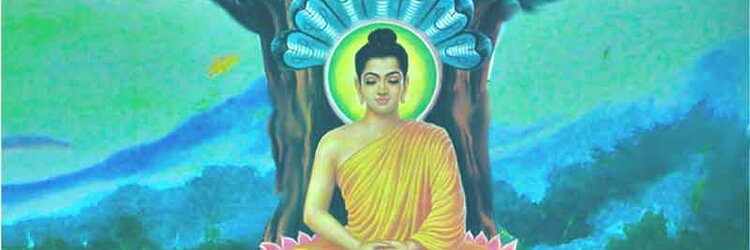
4 Answers
Leave a Reply
You must Register - Login to add an answer.
2 Answers
- Teacher, explain to me what Zen is.
- Black clouds covered the moon. Understood?
- No.
- Go wander for eight years.
The student left, came back after eight years. - Teacher, explain to me what Zen is.
- Black clouds covered the moon. Understood?
- Well, yes.
- What do you understand?
- Well, clouds are evil. The moon is…
- You don't understand anything. Go wander for eight years.
The disciple left and came back after another eight years. - Teacher, explain to me what Zen is.
- Black clouds covered the moon. Understood?
- Understood.
- What do you understand?
- Black clouds covered the moon.
- Well done.
One Bokuju disciple meditated for several years. When he came to the Master, the Master would send him back and say, ” This is all nonsense! Go back and meditate again.” One day, Bokuju came to his house by himself. He was sitting in the lotus position. Bokuju shook him awake and said:
“Why are you sitting like a statue?” We don't need stone statues, we have plenty of them in the temple! Just by sitting like a statue, you will not reach the state of meditation. By calming the body, your mind will not disappear, because it is through the mind that you calm your body. All that is done by the mind will only strengthen the mind.
A year has passed. The teacher came again. The student sat in an almost euphoric state, eyes closed, enjoying the morning breeze and sun.
Bokuju took a brick and began to rub it on the stone in front of the student. The disciple opened his eyes and watched the Master in surprise. Bokuju continued to rub the brick against the stone slab in concentration. Finally, the disciple couldn't stand it anymore and shouted:
— What are you doing?” Do you want to drive me crazy?
Bokuju calmly replied:
— I intend to make a mirror out of this brick!” If you rub it long enough, I think it will become a mirror.
The disciple laughed and said:
— But that's impossible! No matter how much you rub it, a brick will remain a brick.
The teacher said:
“Your answer shows some intelligence!” Then what do you do? For several years you have been trying to extract meditation from the mind-it is like trying to make a mirror out of bricks.
And Bokuju threw a brick into the pond that was next to the tree that the disciple was sitting under. The brick made a splash. That sound was enough to make a miracle happen. Something stirred in the student. The dream was broken, the dream was dispelled, he came to life! For the first time, he tasted something from meditation.
On this topic, I was reminded of a very old (by the standards of the Internet) parable called “Black clouds covered the moon”:
Leave a Reply
You must Register - Login to add an answer.

The koan is a riddle story: its meaning cannot be grasped by logic alone. My favorite Zen Koan is ” A cup of Tea.” It is included in Vladimir Tarasov's book “Japanese Lessons of Russian Koans”, 2019.
Nan-in, a Japanese zen teacher who lived in the Meiji era (1868-1912), hosted a university professor who came to learn what zen is. Nan-ying invited him to tea.
He filled his guest's cup to the brim and continued pouring.
The professor watched as the cup overflowed, and finally broke down:
“It's crowded.” It won't enter again!
“Just like this cup,” Nan – ying said, ” you are full of your own opinions and reflections. How can I show you zen if you haven't emptied your cup first?
The professor is a collective image, so he doesn't have a name here. The professor's” cup of mind “turned out to be unnecessarily filled with the old “tea” of attitudes and thoughts. “Old tea” is an accumulating problem of ossified, cliched knowledge that makes it difficult to live. Since the ” tea ” from his “cup of mind” was already overflowing, he could no longer take fresh knowledge with an open mind. One critical moment came, and the professor went to see the Zen master. Nan-ying immediately guessed what was going on and pointed he has a path to new knowledge. He said he couldn't show him to relax, but he did. In Zen Buddhism, the koan is not told, but shown.
The professor watched the tea pour over the rim of his cup in silence. He probably thought Nan-ying wanted to make sure he filled the cup to the top. He saw the Zen master as a reasonable person, and Nan-ying kept pouring tea, and suddenly the professor saw the absurdity of his actions. After all, it's crazy to fill a full cup of tea to the brim. The professor's mind was caught by surprise and the professor exclaimed worriedly that the cup no longer held tea. The professor's mind decided that Nan-in was inadequate. What he really needed was Nan-in's explanation. The knowledge that filled the professor's “cup of mind” was powerless to resolve the situation.
The main thing is not to fill the cup with tea, but to create and realize the need to empty it. Emptying through filling.
I don't know if it's a parable or a joke, but I'll tell you.�
There was a disciple of the Buddha. A nice guy, but a terrible talker. I couldn't answer any of the simplest questions clearly and concisely, but started monologues for an hour.
The Buddha decided to retrain him and began to do it in the simplest and, like, effective way: as soon as the student starts talking with his tongue, the teacher says to him: “And in short?.. And easier?.. And more specifically?..”
Slowly, but it went on.
One day, a teacher and a student were walking along the road. The Buddha, as always, was thinking about his” high”, and suddenly he heard light footsteps from behind. I asked the student who was going there.
The disciple began in his own way, ” Oh, there's a VERY beautiful young woman following us, She's…”
The Buddha, without coming out of a state of reverie: “And in short?”
A young woman…
You say secondary things, you are biased and full of carnal desires. Speak dispassionately to the point: Who's coming?
– A person…
And even easier!
…………..skeleton………
It was then that the Buddha realized that he had gone too far.
These are not true parables or koans: these are the suttas of the Pali canon:
1)�Dhamma-cakka-pavattana sutta (sutta of starting the wheel of learning). The first sermon of the Dhamma (teaching) by the Buddha. �
Especially like when the chorus chant�”Idaṃ dukkhaṃ ariyasaccanti” me bhikkhave pubbe ananussutesu dhammesu cakkhuṃ udapādi ñāṇaṃ udapādi paññā udapādi vijjā udapādi āloko udapādi. (“This is the noble truth of suffering” – thus, O monks, I have seen things unheard of before, knowledge has been revealed, wisdom has been revealed, knowledge has been revealed, clarity has been revealed.)�
https://www.youtube.com/embed/MCc9A4jFI54?wmode=opaque
2) The Mahasudassana sutta. The story of the life of King cakravartin (world ruler) Mahasudassana, told by Buddha Gotama to his disciple Ananda: “You would think, Ananda, that King Mahasudassana was someone else at that time. But you should not think so, because I was King Mahasudassana at that time.”�
A very strong feeling is produced by this description of a person who has everything, but he is free from attachment to it all.
Two monks were walking from one monastery to another. On the way, they had to ford a stormy river. When they came to the ford, a girl turned to them with a request to help her cross. One of the monks silently picked up the girl in his arms and carried her to the other side of the river, the second reacted to such an act with disapproval. After crossing the river, they went on their way.
About two hours later, the second monk turned to his companion and said::
— You did something wrong, after all. The Scriptures forbid us to touch women, much less hold them in our arms. You shouldn't have done that.
The second monk replied:
— I took the girl to the other side in a minute and forgot about her. You're still carrying it with you.